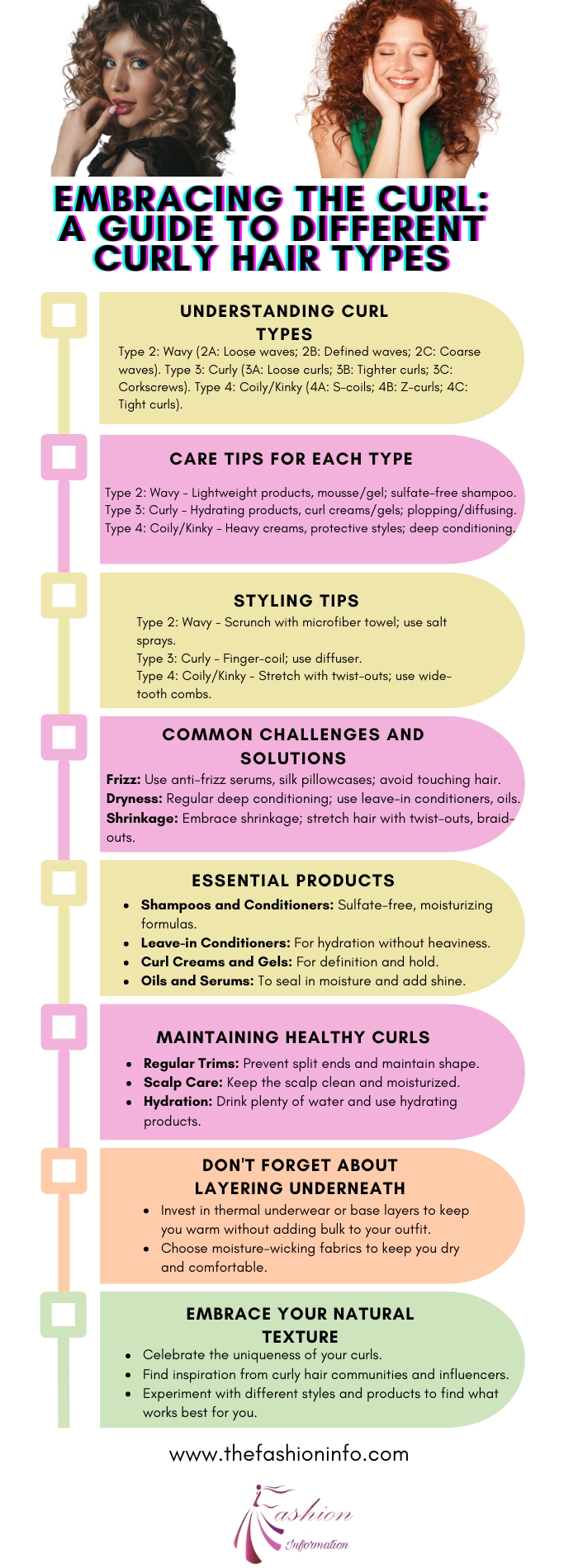Curly hair is a beautiful and diverse texture that comes in a variety of patterns with Curly Hair Types, each with its own unique charm. Understanding your curl type is the first step to embracing and caring for your locks. Join us on a journey through the world of curls as we explore the different curly hair types, decoding the patterns, and celebrating the natural beauty of each curl.
Table of Contents
The Curly Hair Spectrum
Type 2: Wavy Hair

Wavy hair falls into the Type 2 category and is characterized by loose, flowing S-shaped waves. This hair type is further divided into three subtypes:
2A: Slight Waves: Subtle, loose waves that frame the face delicately.
2B: Defined Waves: Waves that are more defined and form a distinct S-shape.
2C: Strong Waves: Waves that are more pronounced, approaching the realm of curls.
Wavy hair is known for its versatility, allowing for both straighter and curlier looks depending on styling choices.
Also Read: 10 Crucial Tips To Get Thicker Hair + Dos And Don’ts
Type 3: Curly Hair
Compared to Type 3 hair is characterized by well-defined curls that follow a spiral or corkscrew pattern. This category is further divided into three subtypes:
3A: Loose Curls: Curls are well-defined and have a loose spiral pattern.
3B: Springy Curls: Spirals are tighter, creating a bouncier, springy effect.
3C: Tight Curls: Curls are tightly packed, forming a more compact pattern.
Curly hair tends to be prone to frizz, but with proper care and styling, it can be incredibly voluminous and stunning.
Type 4: Coily Hair

Additionally Type 4 hair is characterized by tightly coiled or kinky hair with a natural elasticity. This hair type is divided into two main subtypes:
4A: Tightly Coiled Curls: Well-defined coils with an S-shaped pattern.
4B: Z-Shaped Coils: Z-shaped coils that are less defined and have a crimped appearance.
4C: Tightest Coils: The tightest coil pattern, often forming a dense and compact afro.
Coily hair is known for its shrinkage, where the hair appears much shorter than it actually is when stretched.
Also read: Flaunt Your Hairstyle with Dreadlocks on longhair
Understanding Your Curl Pattern
Determining Your Curl Type
Similarly Wash and Detangle: Start with clean, detangled hair to accurately assess your natural curl pattern.
Observe Drying Hair: Therefore allow your hair to air-dry without manipulating it. This will showcase your natural curl pattern.
Compare to Curl Charts: Use curl charts or guides to identify your curl type based on the observed patterns.
Embracing Your Curls
Moisture is Key: Curly hair tends to be dry, so a moisture-rich routine is essential. Use hydrating shampoos, conditioners, and leave-in products.
Avoid Heat Damage: In the same way minimize heat styling to maintain the integrity of your curls. If heat is necessary, use a heat protectant.
Curl-Friendly Haircuts: Opt for haircuts that complement your curl pattern, such as layers for volume or shaping for definition.
Protective Styles: Consider protective styles like braids or twists to minimize manipulation and protect your curls.
Experiment with Products: Curly hair responds differently to various products. Experiment with different gels, creams, and mousses to find what works best for your curls.
Also Read: How To Get Rid Of Static Hair Using 11 Simple Tips
Celebrating Diversity
However no two curls are alike, and that’s the beauty of it. Celebrate the uniqueness of your curls and experiment with different styles to showcase your natural texture. Whether you have loose waves or tight coils, the world of curly hair is a canvas for self-expression and individuality. Embrace your curls, love the journey, and let your hair tell its unique story.
Infographic: Embracing the Curl: A Guide to Different Curly Hair Types


